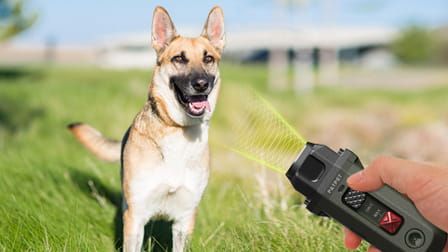Unlike cats, do dogs perceive colors more clearly than cats, sometimes black and white? However, new research into dog anatomy and behavior has shown that although dogs can't see colors like humans, dogs can still see some colors. To understand more about how dogs see color let's discuss some information below.
First we need to know what is the definition of color blindness?
According to some research, the English scientist John Dalton (1766–1844) conducted the first experiment on congenital color blindness in the late 18th century. He was aware of this phenomenon because he and his brother could not recognize some colors. They confuse magenta with green and pink with blue.
In humans, a defect in red-green color perception is the most common form of color deficiency. Up to 8% of men and 0.5% of women of Nordic ancestry are red-green colorblind. It is caused by abnormalities in color-detecting molecules, called cones, in the retina. The retina is a lining at the back of the eye that can convert light into electrical impulses. These signals are then transmitted through the optic nerve to the brain where the images will be formed.
Most people who lack some of these color-detecting molecules (called photoreceptors) won't recognize certain wavelengths of light.
That's what causes them to be color blind, even though they can actually distinguish some colors. People with red-green color blindness can still distinguish between yellow and blue, but objects that are red will appear gray or brown to them.
So are dogs colorblind or spectrum-challenged?

An examination of the structure of a dog's eye has revealed some fundamental design differences between humans and dogs. Function and evolution have driven these differences. Dogs have developed senses as nocturnal hunters, tracking and catching their food at night. As a result, a dog's eyes can adapt to see clearly in the dark and catch movement.
For the purpose of hunting in the dark, dogs' eyes have larger lenses and corneal surfaces as well as reflective membranes, known as tapetums, that enhance night vision. These rods, which improves low-light vision in the retina.
So what is the Retina?
The retina is where scientists have found the key to the difference in color perception between dogs and humans. The retina is made up of millions of cells that sense light and a few other things:
Rods, which are extremely sensitive cells that capture movement and operate in low light conditions.
The cone works in bright light and controls color perception.
Dogs have more rods than cones in their retinas, while humans have more cones, and this clearly makes a difference in color perception. Humans and some other primates are trichromatic, which means they have three types of cones. Dogs come in two colors and only two types.
Each type of cone registers a variant wavelength of light. Red and green make people appreciate the red rose or the Granny Smith apple. Dogs and some color blind people are missing red and blue cones.
On the other hand, there are some fish and birds that can see an even wider range of colors than we can. There are many species of birds and fish that have four colors, which also have a fourth type of cone receptors for UV absorption.
What makes a color?
Color is differentiated through nerve cells in the eye. The eye's retina has two main types of cells—rods, which detect light levels and movement, and cones, which distinguish colors. The eyes of humans have three types of cones that can identify combinations of red, blue, and green. Dogs possess only two types of cones and can only distinguish blue and yellow - this limited color perception is known as dichroic vision.
For us there will be more cones, allowing us to see more colors and see them brighter, but dogs have more rods, which gives them an advantage when seeing in low-light conditions. It lowers light or identifies moving objects.
What is color blindness?
It is known that color blindness is a term used to refer to changes in the ability to perceive colors. With humans, the degree of color blindness depends on which color receptors in the eye are affected. There are two basic types for color blindness in humans: blue-yellow color blindness or red-green color blindness. People with red-green color blindness cannot distinguish these two colors. Often a person with blue-yellow color blindness cannot tell the difference between a yellow shirt and a blue shirt.
When it comes to color discrimination, a dog's normal eyesight is the same as that of a person with red-green color blindness. This indicates that no other degree of color blindness has been observed in dogs in general.
How can dog vision compared to human vision?

Dogs don't appreciate the full spectrum of colors that humans do, which doesn't mean they can't perceive different colors. They just might not see the "true" color of an object.
For red there is dark gray brown or black for dogs. And all the yellows, oranges and greens look a bit yellow to a dog. Dogs see blue very well, but purple looks like blue to them. In popular games such as ball picking, dogs can't distinguish between red and yellow balls. Instead, having a great sense of smell should often be able to identify his ball and avoid getting confused while playing ball games in the park.
In terms of color perception, canines and humans have visual differences. To a certain extent, dogs' vision is not as sharp as human vision. Dogs will be more nearsighted than we are. When looking at an object from the same distance, the object may be clear to us but blurry to dogs. Human canines are also less sensitive to changes in brightness. In essence, dogs simply do not have the ability to perceive colors in rich tones.
What are the other visual differences between dogs and humans?

Canines will have some visual advantage over humans. Dogs have eyes located more on the sides of their heads, which allows them to have a wider peripheral vision. The trade-off is that the range of vision is smaller so dogs don't have the same depth perception as humans.
Dogs have maximally dilated pupils, allowing as much light in as possible. The pet also has reflective cells under the retina, which form the tapetum. Tapetum gives dogs a "light-eyed" appearance and also improves their ability to see in dim light.
Furthermore, dogs also have many rod cells in the retina. The rods are responsible for detecting light and motion, including small movements at great distances. So, when compared to humans, dogs see better in dim light (sunset and sunrise) and can detect movement more accurately.
Why do dogs see what they see?
Dogs have a special intuition that allows them to survive and thrive in the wild. Seeing clearly in dim light and recognizing slight movements in the woods at a distance improves the dog's ability to hunt. These also help a dog know when it is prey and needs to run away.
Can dogs see colors?
The conclusion is that dogs can see colors, but not in the same way that humans do. People see rainbows in many variations, including purple, blue, green, yellow, orange, and red. Dogs can only see blues, yellows, and some shades of gray. See the color chart below for an approximation of the colors dogs see best.
Usually dogs see rainbows in dark yellow (brownish), light yellow, gray, light blue, and dark blue. Dogs don't see red, purple, or orange like we do. So, although it has been established that dogs see shades of yellow, blue, and gray, a dog looking at a uniform that is red or green, it would be light brown, gray or indistinct.
How do dogs see?
A dog's eye acts as a camera. Light that passes through the pupil. The iris, a structure that can expand and contract, controls how much light is allowed to enter. The light then passes through the cornea and transparent lens, focusing the light on the retina, a light-sensitive layer. The retina contains color-sensitive cones and light- and motion-sensitive rods, all of which convert light into electrical signals. The cones and rods send these signals through the optic nerve to the brain, which creates images from them.
In particular, dogs have only two types of cones, compared to three in the human eye. As a result, dogs cannot distinguish as many colors as humans.
Conclusion
Through the sharing above, I believe you will dispel the common misconception that dogs can only see black and white, in fact, they can see colors like blue and yellow, despite the ability to see colors. Their color vision can be much more limited than that of humans. In addition to skin, dogs also have some visual advantages over humans, like being able to see better in the dark.













